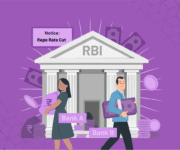The Monetary Policy Committee (MPC), the Reserve Bank of India’s (RBI) rate-setting panel, recently met to decide whether reducing the lending interest rate for banks was the right move to combat rising inflation and economic slowdown.
The news that the current repo rate of 6.5% may be reduced raised widespread concern within the banking sector as it could potentially impact lenders’ profitability.
However, the MPC took a decision to retain the repo rate as is, while the RBI slashed the Cash Reserve Ratio (CRR) by 50 basis points (BPS), i.e. from 4.5% to 4%.
In this blog post, we deconstruct the significance of the latest developments regarding repo rate and CRR and their influence on banking operations.
Snapshot of Recent Events
The role of the MPC is to fix the RBI’s benchmark repo rate, which determines the rate at which banks can borrow funds from the RBI. The recent meeting was triggered by a series of macroeconomic data, which paint a gloomy picture of India’s economy.
These include:
- The GDP in the second quarter of 2024 dipped to 5.4%.
- The inflation metric – the All India Consumer Price Index (CPI)- rose to 6.21 % in October 2024.
- The RBI’s All-India Home Price Index (HPI) soared by 4.34 % to 322 as of September 2024, indicating that the price of homes is rising across the country.
- RBI’s All India Electricity index and inflation, as of October 2024, grew to 162.5 and 5.45%, respectively. In September 2024, these figures were pegged at 162.4 and 5.39%, respectively.
These data points collectively signify a slowdown in economic growth and a rise in inflation.
Significance of the Repo Rate on the Economy
The RBI leverages the repo rate to control inflation and drive growth. Let’s understand how these mechanisms work:
When the repo rate is reduced, banks can pass on the benefit of lower interest rates to their customers by both:
- Reducing interest rates for home loans and other types of loans to help drive revenues and growth.
- Offering a higher interest rate on Savings and Fixed deposits, which helps increase rupee deposits.
For instance, in 2015, the RBI reduced the repo rate by 1.5%, and banks reduced their lending interest rates by 0.5%.
The flipside of a reduced repo rate is its impact on inflation. Historically, the RBI has leveraged the repo rate to control the rise of inflation. A change in the repo rate has a domino effect on the prevailing inflation rate:
- A higher repo rate makes it more expensive for banks to borrow from the RBI and reduces the money supply in the economy, discouraging consumers from spending and, in turn, controlling inflation.
- Alternatively, a lower repo rate makes it cheaper for banks to borrow from the RBI and triggers a higher money supply in the economy. This encourages borrowing and spending. A rise in consumer demand triggers price rises and, in turn, a rise in inflation.
Suppose the RBI reduces the repo rate in a market scenario where the price of goods and services is already high. In that case, this approach can result in reduced borrowing and negatively impact a bank’s profitability.
Significance of Lower CRR for Banks
As per the CCR, banks must maintain a certain amount of liquidity to manage their operations. This regulation aims to help banks be prepared for eventualities such as market downturns and financial losses due to fraud.
The recent move to lower CRR aims to boost the liquidity in the financial system. Banks can direct some of their liquid capital towards lending rather than letting it sit in reserve.
However, expanding too quickly can be risky. Hence, the best approach for banks is to allocate funds strategically; they must fuel growth while balancing risk.
Leveraging Tech to Navigate Regulatory Shifts
Here are five key strategies that banks can leverage to become more efficient and proactive in responding to market shifts:
1. Harness Predictive Analytics
With advances in AI-powered protective Analytics, banks can use historical data to forecast future performance.
For instance, they can use historical and potential benchmarks such as the repo rate and CRR to forecast future performance. Based on the results, they can strategise and optimise operations to thrive through regulatory shifts.
2. Comprehensive Financial Analysis
A reduced CRR means that lenders can channelise more liquid cash into funding more loans. This is where superior, automated, and data-driven financial analysis can help lenders drive revenues while also managing risk.
Such a comprehensive approach helps lenders account for every bank transaction. They can use alternative data to review a borrower’s financial status accurately and be more inclusive.
The use of AI in the financial analysis process can also help lenders strengthen fraud detection capabilities.
3. Automate Key Processes
As businesses scale, they can no longer afford human interventions across the loan management lifecycle.
By automating the entire workflow through the use of a cloud-based loan management system, lenders can reduce errors and strengthen data security. They can bring in more efficiency and accuracy across the loan life cycle.
4. Deliver Customised Solutions
Lenders can capture more customers by personalising products and services. By doing so, they can make their offerings relevant to diverse audiences.
Furthermore, automating this process can help them reach a larger number of customers, decrease turnaround time on loan approvals, and expand their customer base.
5. Build a Robust Debt Recovery System
Many banks focus extensively on acquiring new customers. In the process, they do not strategise enough to recover the debt. However, with the adoption of a robust debt recovery system, banks scan and monitor debt collection more effectively.
They can initiate communication with delinquent borrowers early on in the cycle and work towards recovering debt much faster and efficiently.
The Takeaway
Benchmarks such as the repo rate and CRR can impact banks’ liquidity, revenues, and profitability. Though these factors are out of their control, banks can take measures to manage their operations more optimally in shifting market conditions.
Early investments in tech-enabled solutions can help banks future-proof themselves and be prepared for varied circumstances.
Finezza offers a comprehensive set of tools and solutions to manage your lending portfolio. The intuitive bank statement analysis software is geared to analyse bank statements with speed and accuracy and detect potential fraud more effectively. Also, our cloud-based Loan Management System comes with the following features:
- Supports multi-loan types and multi-disbursements
- Flexible payment modules
- Bank payment reconciliation
- NPA management
- Restructuring of loans
- Collection management
- Effective loan communication management
Our end-to-end lending management solutions are trusted by brands like ftcash, Hiranandani Financial Services, gromor Finance, and UC Inclusive Credit, to name a few.
Book a demo to know more.




Leave a Reply